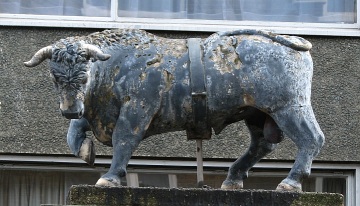
Free-standing Victorian or Edwardian statues of bulls, or sculptural groups incorporating them, seem to be uncommon. The one which immediately leaps to mind is the great group outside Tate Britain, The Punishment of Dirce, by the flamboyant sculptor Lawes-Witteronge. Dirce, we may recall, was tied to a savage bull by the twin sons of Antiope, her relative whom she had maltreated. The bull was then set free, so that she would be gored to death by the enraged animal’s horns. The famous Farnese Bull from antiquity was based on this story. Lawes-Witteronge’s sculpture has the bull as a massive animal rearing up in the centre of the pyramidal group, pretty well encircled by the three nude figures of the twins, fighting to constrain him, and the figure of Dirce across his side and back. The bull’s horns curve wickedly outwards, and with his outstretched front hooves and the raised hand of Dirce, make a fine silhouette.
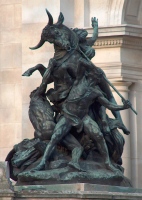 The Punishment of Dirce, by Lawes-Witteronge.
The Punishment of Dirce, by Lawes-Witteronge.
The story of Europa and the Bull is a familiar one, whereby Zeus, espying the attractive Europa, went down into her family’s herds, and transformed himself into a handsome bull. Europa rather took a fancy to the animal, climbed on his back, and was carried away to Crete where the god resumed his true form. The main sculptured group of the story in England is of course the centrepiece of MacDowell’s Europe group for the Albert Memorial in London. A very placid bull this, and a very calm Europa on his back. But we may observe that Europa and the Bull is a far more common subject in other countries than in Britain.
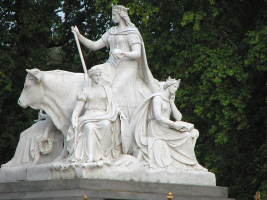 Europa and the Bull, by MacDowell.
Europa and the Bull, by MacDowell.
We do see the occasional free-standing bull statue, as in the example at the top of this page from an Edwardian tavern, which now stands in Hammersmith. And there are modern examples, notably a particularly large one to mark the Bull Ring in Birmingham. Bulls in architectural sculpture are more common. Below left is a large one on St Paul’s Cathedral, with a saint; as a religious bull, we can espy a wing sprouting from his shoulder – more on winged bulls further down this page. A nice example of bulls in low relief is found in the panel below centre by Flaxman on the front of the Royal Opera House in London. And below right is a pastoral scene with cows, and sheep, from the curved pediment of a late 19th Century portico.
This brings us to bulls in relief accompanied by female figures. Below left, a figure perhaps emblematic of Europe in a spandrel, with a bull behind her filling the right angle of the field; the horns on this specimen are short and not sharp; as with others of the breed, it is shown with curly hair between the horns. Centremost is one of the tympani from the Manchester Free Trade Hall, with a seated bull, again of a calm disposition and with short horns. It is the work of the sculptor John Thomas. And below right is another spandrel containing a woman stroking the head of a rather serious and particularly hairy bull.
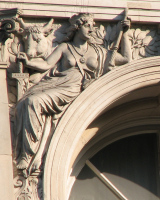
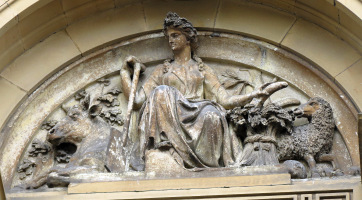
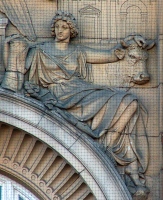 Bull sculpture in high relief with female figures.
Bull sculpture in high relief with female figures.
Smaller examples are also found. Here, under a Gothic arch, is the decayed relief of an Indian bull with its distinctive humped back, an exotic beast on the Readymony Fountain in Regents Park. Next, another bull decorating Gothic architecture, his head poking out from behind some artisan climbing among foliage. The familiar short horns and furry forehead are present, and this bull portrait also shows an unusually short face, almost snub. Below right is another standing bull, very small, on the top of a pilaster. The robed man next to him appears to be applying a brand to its flank.
Bulls’ heads make a nice symmetrical architectural decoration. Below left, we have an example forming a boss on a pilaster, rather naturalistic, but made entirely symmetrical and with the horns decorative than anything else. Indeed, so far are they curled round that they give the impression of a sheep rather than a bull. In the centre is a keystone with a short-horned bull, ring through its nose, somewhat anthropomorphised with the treatment of eyes and mouth, though it looks less so from the side. Below right is a terra cotta example from Northampton.
Bulls make good heraldic beasts, as they can be shown quite naturally, or at least plausibly, rearing up, and here is an example of such a ‘bull rampant’ as part of a coat of arms along with a stag and what might be a small falcon. As in the last example above, this sculpture is from Northampton.
Finally, a brief word on winged bull sculptures, promised at the top of this page. Such creatures are generally found on churches. The one which leaps to my mind is a free-standing bronze winged bull sculpture, high on the tower of the Agapemeni church in Stamford Hill, the work of the sculptor A. G. Walker. There are lots of others though, typically accompanied by other winged beasts. Below are a terra cotta example in a roundel, accompanied by an eagle, a small bull with wings and halo from a church porch, and, below right and most unlikely, a winged bull in a double spandrel which appears to have his front legs crossed.
Visits to this page from 13 Mar 2014: 9,990
Animal sculpture // Allegorical sculpture